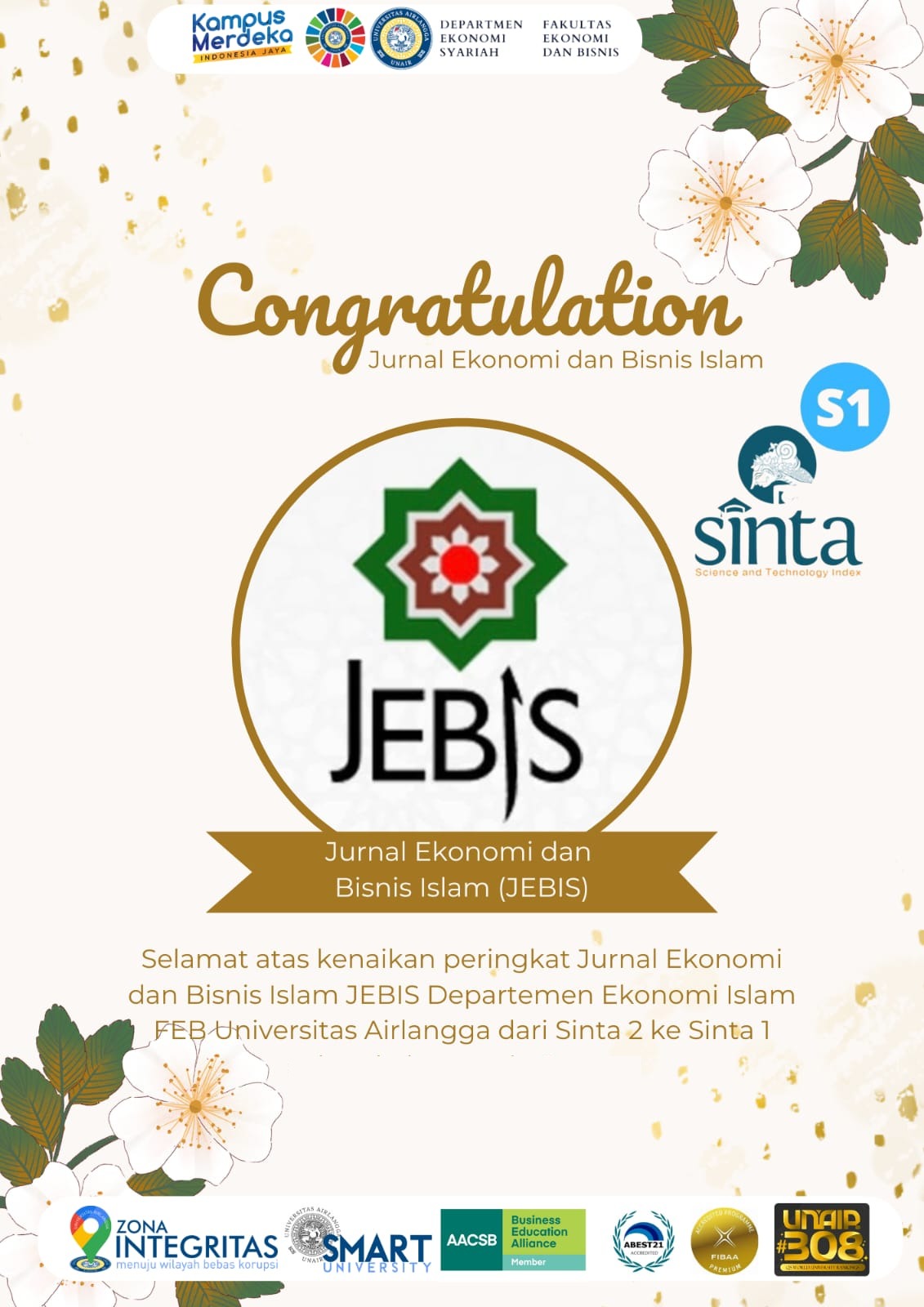INTERNAL AND EXTERNAL FACTORS AFFECTING ISLAMIC BANKS PERFORMANCE IN NIGERIA
Downloads
The purpose of the paper is to analyze the internal and external factors affecting the performance of Islamic banking in Nigeria. The study is quantitative research that applies the generalized least square (GLS) regression to measure the effect of independent variables on the dependent variables. Data is generated from the published financial statements of the bank from the year of inception, 2012 to 2020. The dependent variables used to measure the performance are return on assets (ROA) and return on equity (ROE). The independent internal variables are measured using the financial deposit ratio (FDR) and operational efficiency ratio (OER), while the external factors are measured using gross domestic product (GDP) and inflation. The findings for the internal factors show that FDR has a positive and significant effect on performance, indicating the availability of liquidity when required by depositors. OER also showed a significant positive effect on ROA and ROE, meaning that high operational efficiency can increase efficiency and performance. Meanwhile, external factors, GDP, show a significant negative effect on performance, implying that an increase in GDP per person will increase population, decreasing real GDP. More so, inflation also showed a negative and significant effect on performance, which implies that when there is inflation, the Central Bank increases the interest rate to slow down the inflation rate. However, interest is not permissible in an Islamic bank's operation, hence not affecting its performance.
Ahmad, A. (1987). Development and Problems of Islamic Banks. Islamic Research and Training Institute.
Ahmad, Z. (1984). Concept and Models of Islamic Banking: An Assessment. International Institute of Islamic Economics.
Akhter, W., Raza, A., Orangzab, O., & Akram, M. (2011). Efficiency and Performance of Islamic Banking: The Case of Pakistan. Far East Journal of Psychology and Business, 2(2), 54–70.
Al-Tamimi, H. A. H. (2010). Factors Influencing Performance of The UAE Islamic Conventional National Banks. Global Journal of Business Research, 4(2), 1–9. https://ssrn.com/abstract=1633110
Almazari, A. A. (2014). Impact of Internal Factors on Bank Profitability: Comparative Study between Saudi Arabia and Jordan. Journal of Applied Finance & Banking, 4(1), 125–140.
Ameur, I. G. B., & Mhiri, S. M. (2013). Explanatory Factors of Bank Performance: Evidence from Tunisia. International Journal of Economics, Finance and Management, 2(1), 143–152.
Bilal, M., Saeed, A., Gull, A. A., & Akram, T. (2013). Influence of Bank Sepecific and Macroeconomic Factors on Profitability of Commercial Banks: A Case Study of Pakistan. Research Journal of Finance and Accounting, 4(2), 117–126.
Chua, Z. (2013). Determinants of Islamic Banks Profitability in Malaysia. https://doi.org/10.2139/ssrn.2276277
Dietrich, A., & Wanzenried, G. (2014). The Determinants of Commercial Banking Profitability in low-, middle-, and high-, Income Countries. The Quarterly Review of Economics and Finance, 54(3), 337–354. https://doi.org/10.1016/j.qref.2014.03.001
Francis, M. E. (2013). Determinants of Commercial Bank Profitability in Sub-Saharan Africa. International Journal of Economics and Finance, 5(9), 134–147. https://doi.org/10.5539/ijef.v5n9p134
Hanif, M., Tariq, M., Tahir, A., & Wajeeh-ul, M. (2012). Comparative Performance Study of Conventional and Islamic Banking in Pakistan. International Research Journal of Finance & Economics Issue, 82. https://ssrn.com/abstract=1959950
Hasbi, H., & Haruman, T. (2011). Banking: According to Islamic Syaria Concepts and Its Performance in Indonesia. International Review of Business Research Paper, 7(1), 60–76.
Istan, M., & Fahlevi, M. (2020). The Effect of External and Interbal Factors on Financial Performance of Islamic Banking. Jurnal Ekonomi & Studi Pembangunan, 21(1). https://doi.org/10.18196/jesp.21.1.5036
Javaid, S., Anwar, J., Zaman, K., & Ghafoor, A. (2011). Determinants of Bank Profitability in Pakistan: Internal Factor Analysis. Journal of Yasar University, 23(6), 3794–3804.
Khan, M. A., Akhtar, W., Ullah, A., Iqbal, Z., & Riasat, I. (2013). Islamic Banking: An Appraisal of Insolvency Hazzard. International Journal of Academic Research in Accounting, Finance and Management Sciences, 3(4), 1–10. https://doi.org/10.6007/IJARAFMS/v3-i4/269
Kosmidou, K., Tanna, S., & Pasiouras, F. (2005). Determinants of Profitability of Domestic UK Commercial Banks: Panel Evidence from the period 1995-2002. Money, Macro and Finance (MMF) Research Group, 1–27.
Loke, J. C., Ong, E. P., Lim, S. Sen, & Yeoh, S. C. (2015). Factors Affecting Performance of Islamic Banks and Conventional Banks: Evidence from Malaysia [Universiti Tunku Abdul Rahman]. http://eprints.utar.edu.my/id/eprint/1523
Muda, M., Shaharuddin, A., & Embaya, A. (2013). Profitability Determinants and The Impact of Global Financial Crisis: A Panel Data Analysis of Malaysian Islamic Banks. Research Journal of Finance and Accounting, 4(7), 121–130.
Muhammad, A. U., & Yusoff, M. (2021). Shari'ah Non-Compliance Risk and Performance of Islamic Banks in Africa. Universiti Sains Malaysia.
Obamuyi, T. M. (2013). Determinants of Banks' Profitability in A Developing Economy: Evidence from Nigeria. Organizations and Markets in Emerging Economies, 4(2), 97–111. https://www.ceeol.com/search/article-detail?id=269858
Pasiouras, F., & Kosmudou, K. (2007). Factors Influencing the Profitability of Domestic and Foreign Commercial Banks in the European Union. Research in International Business and Finance, 21(2), 222–237. https://doi.org/10.1016/j.ribaf.2006.03.007
Ramadan, I. Z., Kilani, Q. A., & Kaddumi, T. A. (2011). Determinants of Bank Profitability: Evidence from Jordan. International Journal of Academic Research, 3(4), 180–191.
Rao, K. R. M., & Lakew, T. B. (2012). Determinants of Profitability of Commercial Banks in a Developing Country: Evidence from Ethiopia. International Journal of Accounting and Financial Management Research, 2(3), 1–20.
Saleh, A. S., & Zeitun, R. (2006). Islamic Banking Performance in the Middle East: A Case Study of Jordan. https://ro.uow.edu.au/commwkpapers/157
Setyawati, I., Suroso, S., Suryanto, T., & Nurjannah, D. S. (2017). Does Financial Performance of Islamic Banking is Better? Panel Data Estimation. European Research Studies Journal, 20(2A), 592–606.
Sufian, F. (2009). Factors Influencing Bank Profitability in a Developing Economy: Empirical Evidnce from Malaysia. Global Business Review, 10(2), 225–241. https://doi.org/10.1177/097215090901000206
Tanko, M., Alhaji, Y., & Dabo, Z. (2016). An Empirical Analysisi of The Performance of Islamic Banking in Nigeria: A DEA Approach. https://doi.org/10.2139/ssrn.2838637
Wasiuzzaman, S., & Tarmizi, H.-A. B. A. (2010). Profitability of Islamic Banks in Malaysia: An Empirical Analysis. Journal of Islamic Economics, Banking and Finance, 6(4), 53–68.
Yulianto, A., & Solikhah, B. (2016). The Internal Factors of Indonesian Sharia Banking to Predict the Mudharabah Deposits. Review of Integrative Business & Economics, 5(1), 210–218.
Copyright (c) 2022 Jurnal Ekonomi dan Bisnis Islam | Journal of Economics and Business Islamic

This work is licensed under a Creative Commons Attribution-NonCommercial-ShareAlike 4.0 International License.
- Every manuscript submitted to JEBIS must obey to the policy and terms set by Journal of Economics and Business Islamic.
- Publication rights on the contents of manuscript published by JEBIS is owned by JEBIS under consent and approval by the corresponding author(s).
- Full text of electronic publication of manuscripts can be accessed free if used for the purpose of education and research according to copyright regulation.
- Share ” copy and redistribute the material in any medium or format
- Adapt ” remix, transform, and build upon the material
- You must give appropriate credit, provide a link to the license, and indicate if changes were made. You may do so in any reasonable manner, but not in any way that suggests the licensor endorses you or your use.
- You may not use the material for commercial purposes.
- If you remix, transform, or build upon the material, you must distribute your contributions under the same license as the original.
Creative Commons Attribution-NonCommercial-ShareAlike 4.0 International License.





.png)














